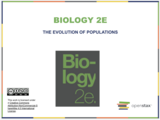
The Biology I Course was developed through the Ohio Department of Higher Education OER Innovation Grant. The course is part of the Ohio Transfer Assurance Guides and is also named OSC003. This work was completed and the course was posted in October 2019. For more information about credit transfer between Ohio colleges and universities, please visit: www.ohiohighered.org/transfer.Team LeadCathy Sistilli Eastern Gateway Community CollegeContent ContributorsLisa Aschemeier Northwest State Community CollegeShaun Blevins Rhodes State CollegeRachel Detraz Edison State Community College Sara Finch Sinclair Community CollegeWendy Gagliano Clark State Community College AJ Snow University of Akron Wayne CollegeLibrarianAmanda Rinehart Ohio State UniversityReview TeamJessica Hall Ohio Dominican UniversitySanhita Gupta Kent State UniversityErica Mersfelder Sinclair Community College
- Subject:
- Biology
- Life Science
- Material Type:
- Full Course
- Provider:
- Ohio Open Ed Collaborative
- Date Added:
- 01/09/2019

